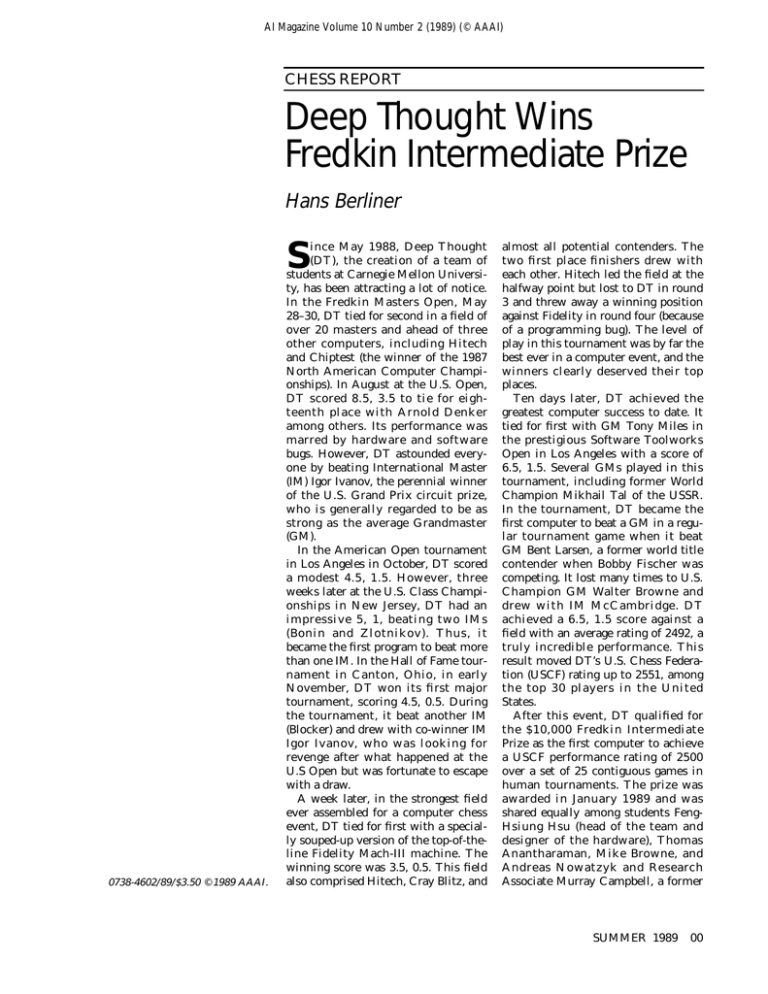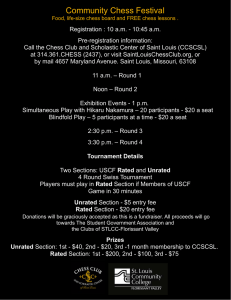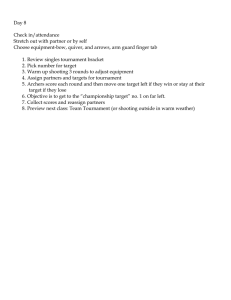Deep Thought Wins Fredkin Intermediate Prize Hans Berliner CHESS REPORT
advertisement

AI Magazine Volume 10 Number 2 (1989) (© AAAI) CHESS REPORT Deep Thought Wins Fredkin Intermediate Prize Hans Berliner S 0738-4602/89/$3.50 © 1989 AAAI. ince May 1988, Deep Thought (DT), the creation of a team of students at Carnegie Mellon University, has been attracting a lot of notice. In the Fredkin Masters Open, May 28–30, DT tied for second in a field of over 20 masters and ahead of three other computers, including Hitech and Chiptest (the winner of the 1987 North American Computer Championships). In August at the U.S. Open, DT scored 8.5, 3.5 to tie for eighteenth place with Arnold Denker among others. Its performance was marred by hardware and software bugs. However, DT astounded everyone by beating International Master (IM) Igor Ivanov, the perennial winner of the U.S. Grand Prix circuit prize, who is generally regarded to be as strong as the average Grandmaster (GM). In the American Open tournament in Los Angeles in October, DT scored a modest 4.5, 1.5. However, three weeks later at the U.S. Class Championships in New Jersey, DT had an impressive 5, 1, beating two IMs (Bonin and Zlotnikov). Thus, it became the first program to beat more than one IM. In the Hall of Fame tournament in Canton, Ohio, in early November, DT won its first major tournament, scoring 4.5, 0.5. During the tournament, it beat another IM (Blocker) and drew with co-winner IM Igor Ivanov, who was looking for revenge after what happened at the U.S Open but was fortunate to escape with a draw. A week later, in the strongest field ever assembled for a computer chess event, DT tied for first with a specially souped-up version of the top-of-theline Fidelity Mach-III machine. The winning score was 3.5, 0.5. This field also comprised Hitech, Cray Blitz, and almost all potential contenders. The two first place finishers drew with each other. Hitech led the field at the halfway point but lost to DT in round 3 and threw away a winning position against Fidelity in round four (because of a programming bug). The level of play in this tournament was by far the best ever in a computer event, and the winners clearly deserved their top places. Ten days later, DT achieved the greatest computer success to date. It tied for first with GM Tony Miles in the prestigious Software Toolworks Open in Los Angeles with a score of 6.5, 1.5. Several GMs played in this tournament, including former World Champion Mikhail Tal of the USSR. In the tournament, DT became the first computer to beat a GM in a regular tournament game when it beat GM Bent Larsen, a former world title contender when Bobby Fischer was competing. It lost many times to U.S. Champion GM Walter Browne and drew with IM McCambridge. DT achieved a 6.5, 1.5 score against a field with an average rating of 2492, a truly incredible performance. This result moved DT’s U.S. Chess Federation (USCF) rating up to 2551, among the top 30 players in the United States. After this event, DT qualified for the $10,000 Fredkin Intermediate Prize as the first computer to achieve a USCF performance rating of 2500 over a set of 25 contiguous games in human tournaments. The prize was awarded in January 1989 and was shared equally among students FengHsiung Hsu (head of the team and designer of the hardware), Thomas Anantharaman, Mike Browne, and Andreas Nowatzyk and Research Associate Murray Campbell, a former SUMMER 1989 00 student who is employed on the Hitech project. DT’s record against GMs is now 1, 2 and against IMs 5, 2. These results mark its performance as at least a strong IM. DT is a dual-processor chess machine in which 450,000 positions per second can be done by each processor and 700,000 per second by the two working together. These figures make it the fastest chess machine ever, about five times faster than Hitech. DT’s predecessor, Chiptest, used only one of the move generator chips in DT but was good enough to win the 1987 North American Computer Championships with a perfect score in a field that included Cray Blitz, Belle, Lachex, and Phoenix. One reason (and we consider it the major reason) for the recent exceptional computer performances is the discovery, by several members of the DT team, of a new search algorithm 00 AI MAGAZINE that operates within the framework of the brute-force full-width alpha-beta search. This algorithm, called singular extensions, makes it possible at minimal cost to detect that one move of a sibling set is clearly better than any other alternative (Anantharaman, T., Campbell, M., and Hsu, F. 1988. Singular Extensions: Adding Selectivity to Brute Force Searching. Paper presented at the 1988 AAAI Spring Symposium on Computer Game Playing, 22–24 March 1988, Stanford, California). Such moves play a powerful role in determining forcing and forced lines of play. Therefore, the algorithm does not count such singular moves as a ply toward the prespecified depth, as is normally done. The result is that on the average, an N ply search penetrates along the principal variation to a depth of 1.5N and reaches a depth of 3N about once in a game. This result means that at times, variations as long as 30 ply are returned, and this kind of calculation can tax the ability of the world’s best human players. DT has announced a mate in 19 moves (37 ply) in an actual game, and Chiptest and Hitech have also performed similarly, although somewhat less deep. For those interested in more detail on current computer chess activity, I suggest joining the Inter national Computer Chess Association, which produces a quarterly journal that covers these events in detail. Subscriptions (US $25/year) can be sent to Jonathan Schaeffer, Department of Computing Science, University of Alberta, Edmonton, Alberta, Canada T6G 2H1. Hans Berliner is a principal research scientist in the Department of Computer Science, Carnegie Mellon University, Pittsburgh, PA 15213.


